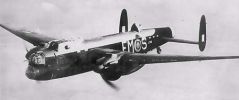
Avro Manchester486 viewsThe Avro Manchester had a relatively brief service career, from November 1940 to June 1942, largely because of problems associated by the unreliability and eventual lack of power shown by the Rolls-Royce Vulture I engines with which it was fitted. The bomber could, however, maintain height on one engine, and in one case an aircraft flew 600 miles from Berlin to its base in England after having had an engine knocked out by gunfire in addition to other extensive damage. In addition to a 10,350 pound bomb load in cavernous bomb-bay nearly half the length of the fuselage, the armament consisted of eight .303-inch machine-guns: two in the nose, two in a dorsal turret, and four in a turret in the tail.
Though unsuccessful the Avro Manchester design demonstrated sufficient promise to warrant further modification.
|
|
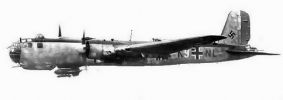
Heinkel He 177515 viewsThe He 177 was a try to devellop a real strategic bomber. The idea to combine two motors on one propeller lead to heavy problems. Due to this and other misstakes in construction, the plane became a deadly trap for many crews and got the the nick-name "Lighter of the Reich". The He 177 saw first operational service in 1942 and was mainly used for maritime warfare in the west. In the mid of 1944 87 He 177 flew an attack on Velikye Luki at the east-front. At the end of the war one machine was modified to carry a german atomic bomb.
|
|
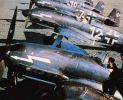
Heinkel He 100521 viewsDisappointed by the loss of the Luftwaffe's fighter orders to BFW and it's Bf 109 and the failure of the He 112, Heinkel set out to build a lighter and faster fighter that was also cheaper and easier to build. Even though the He 100 broke several world speed records, the RLM was solidly supportive of the Bf 109 and failed to order the He 100 into production. Six prototypes were eventually sold to the Soviet Union and three He 100D-0 went to Japan. The three He 100D-0's being armed with two MG 17 and a 20mm MG/FF. The remaining 12 He 100D-1 fighters were used to form a Heinkel-Rostock factory defense unit
|
|
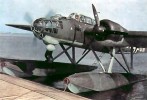
Heinkel He 115486 viewsThe He 115, constructed as a twin engine plane was very effective in it's role as mine-layer and torpedo-bomber (first flight in 1936).
In 1940 the He 115B saw service as a mine-layer, carrying a single magnetic mine of 920 kg. Airplanes of Küstenfliegergruppe 106 und 406 flew on a regularly basis mining missions at the east and south coast of Great Britain. At the end of 1940 the He 115 C appeared with heavy armament; a subversion had improved skids for landings on ice and iced snow. The C-4 was a version specialised for torpedo-attacks, which was used several times against the north-cape convoys.
|
|
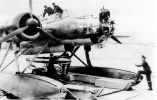
Heinkel He 115492 viewsThe He 115, constructed as a twin engine plane was very effective in it's role as mine-layer and torpedo-bomber (first flight in 1936).
In 1940 the He 115B saw service as a mine-layer, carrying a single magnetic mine of 920 kg. Airplanes of Küstenfliegergruppe 106 und 406 flew on a regularly basis mining missions at the east and south coast of Great Britain. At the end of 1940 the He 115 C appeared with heavy armament; a subversion had improved skids for landings on ice and iced snow. The C-4 was a version specialised for torpedo-attacks, which was used several times against the north-cape convoys.
|
|
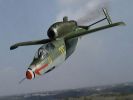
Heinkel He 162618 viewsThe Heinkel He 162 Volksjäger was the second jet engined fighter aircraft to be fielded by the Luftwaffe in WWII. It is know primarily for a series of spectacular disasters during testing. Nevertheless the ambitious production program continued and 300 were complete by the war's end, with another 100 ready for delivery. Only one gruppen had completely re-formed with the He 162 in late April, and they claimed two or three planes in combat before their base was taken over by the British in early May.
|
|
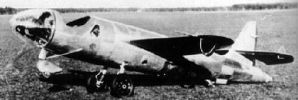
Heinkel He 176695 viewswas the world’s first aircraft to be propelled solely by a liquid-fuelled rocket, making its first powered flight on July 20 1939 with Erich Warsitz at the controls. The He 176 was built to utilise one of the new Walter engines. It was a tiny, simple aircraft, built almost entirely out of wood and lacking even an enclosed canopy. It had a conventional, fixed, tricycle undercarriage, but relied on the weight of the pilot to actually rest on its wheels. Empty, the tail of the plane rested on the ground. Heinkel demonstrated the aircraft to the RLM, but official disinterest led to the abandonment of the company's rocket propulsion programme. The He 176 was placed in the Deutsches Technikmuseum ("German Technical Museum") in Berlin, where it was destroyed in an air raid during World War II.
|
|
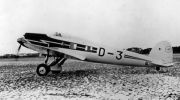
Heinkel He 70516 viewsThe Heinkel He 70 was an aircraft designed as a fast mailplane, inspired by the Lockheed Orion. Its streamlining inspired many other designs. Although useful, it had a relatively brief commercial career, before it was replaced by types which could carry more passengers. As a combat aircraft it was a not a great success, because it rapidly became outdated.
|
|
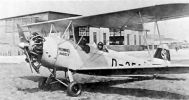
Heinkel He 72516 viewsThe Kadett was introduced in the Luftwaffe in 1933, when the latter was not yet official. It remained one of the most wideley used German primary trainers until 1944. Although it lacked power, it was a pleasant plane to fly and quite comparable to the British Tiger Moth.
Almost all Kadett were He 72B, of which the prodcution took place from 1934 until 1936. After that, only models with a limited number of examples remained in production (He 72BW, He 72B-3). A single example was tested by the Japanese Navy as the "KXHe1"
|
|
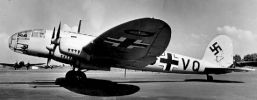
Heinkel He 116488 viewsThis aircraft was designed in 1936 as a high altitude aircraft for Lufthansa. The specified Hirth powerplants were not available and the V1 flew in 1937 on lower rated engines. Eight A-series mail carriers were built followed by the He 116R with rocket boost. The He 116R later flew 6,214 (10,000km) on June 30, 1938 non-stop. Six B-0 were delivered to the Luftwaffe in 1938 as long range photo recon aircraft but their low speed, lack of pressurization and lack of armament made them too vulnerable to use in enemy airspace and these airframes spent the remainder of their careers doing photographic work over Germany.
|
|

Savoia-Marchetti S.73596 viewsThree-engined transport aircraft, a low-wing airplane with fixed landing gear. Its lines would become typical for the Savoia- Marchetti designs. Some were used by the Italian airforce, including four which -- having originally been sold to Belgium -- had served with the RAF before they were captured in North Africa!
|
|
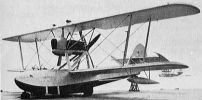
Savoia-Marchetti S.62600 viewsBiplane flying boat. The S.62 was not accepted by the Italian armed forces, but some were built for civilian operators and 24 for the USSR. 29 more were built in the USSR.
|
|
|
|